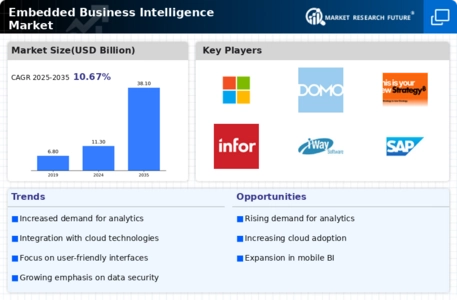Emphasis on Enhanced User Experience
The Embedded Business Intelligence Market is increasingly focusing on enhancing user experience as a key driver of adoption. Organizations recognize that user-friendly interfaces and intuitive design are essential for encouraging the use of embedded analytics tools among employees. By prioritizing user experience, companies can ensure that their analytics solutions are accessible and effective, leading to better decision-making outcomes. Market Research Future indicates that organizations that invest in improving user experience in their analytics platforms can see a 30% increase in user engagement. This emphasis on user experience is likely to propel the growth of the embedded business intelligence market, as businesses strive to create a culture of data-driven decision making.
Rising Adoption of Cloud-Based Solutions
The Embedded Business Intelligence Market is significantly impacted by the rising adoption of cloud-based solutions. Organizations are increasingly migrating their analytics capabilities to the cloud to benefit from scalability, flexibility, and cost-effectiveness. Cloud-based embedded analytics solutions allow businesses to access data from anywhere, facilitating collaboration and enhancing decision-making processes. Market data suggests that the cloud analytics market is expected to grow at a CAGR of over 25% in the coming years, indicating a strong shift towards cloud adoption. This trend is likely to drive the embedded business intelligence market as companies seek to integrate cloud capabilities into their analytics strategies, ensuring they remain competitive in a rapidly evolving landscape.
Growing Importance of Real-Time Data Access
The Embedded Business Intelligence Market is witnessing a growing emphasis on real-time data access, which is becoming a critical factor for organizations aiming to stay agile and responsive. The ability to access and analyze data in real-time allows businesses to make timely decisions, respond to market changes, and enhance customer experiences. As organizations increasingly adopt digital transformation strategies, the demand for embedded analytics solutions that provide real-time insights is expected to rise. This trend is reflected in market data, indicating that companies investing in real-time analytics are likely to achieve a 20% increase in operational efficiency. Consequently, the focus on real-time data access is driving the growth of the embedded business intelligence market.
Increased Demand for Data-Driven Decision Making
The Embedded Business Intelligence Market experiences a notable surge in demand as organizations increasingly recognize the value of data-driven decision making. Companies are leveraging embedded analytics to enhance operational efficiency and improve strategic planning. According to recent estimates, the market for embedded analytics is projected to grow at a compound annual growth rate of approximately 15% over the next five years. This growth is driven by the need for real-time insights and the ability to make informed decisions quickly. As businesses strive to remain competitive, the integration of embedded business intelligence tools becomes essential, allowing them to harness data effectively and gain a competitive edge.
Advancements in Artificial Intelligence and Machine Learning
The Embedded Business Intelligence Market is significantly influenced by advancements in artificial intelligence (AI) and machine learning (ML). These technologies enable organizations to analyze vast amounts of data more efficiently, uncovering patterns and insights that were previously difficult to detect. The integration of AI and ML into embedded analytics solutions enhances predictive capabilities, allowing businesses to anticipate market trends and customer behavior. As a result, organizations are increasingly adopting these technologies to improve their decision-making processes. The market for AI-driven analytics is expected to witness substantial growth, further propelling the embedded business intelligence sector as companies seek to leverage intelligent solutions for better outcomes.


















Leave a Comment